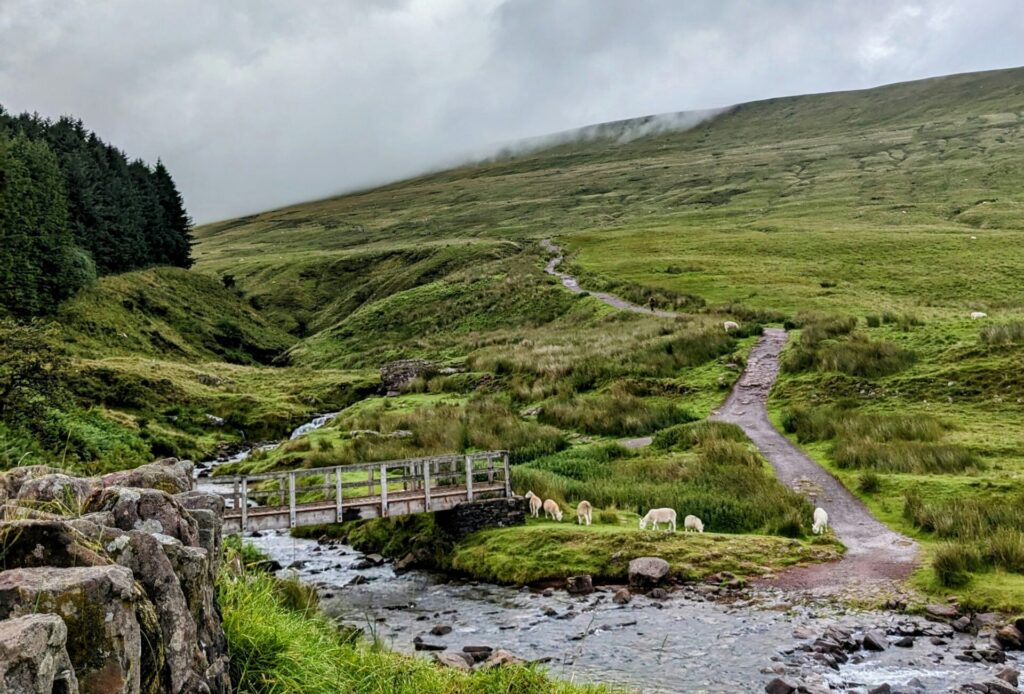Bethany Handley envisions a future where access to nature is supported for all.
2100
It’s a bright, bitter day in October and Autumn is yet to commit. The forest flickers by, a patchwork of orange and green hues as if each cluster of trees belongs to a different season. I study the Ordnance Survey App, tracing the route with my index finger. For the third time this morning, I check for terrain type and the surface of the path. I study the boundaries to check for gate types and stiles, out of habit rather than need. This route should be free from residual stiles, kissing gates or storm drains disrupting the paths.
The door of the bus automatically opens as I wheel up to it and the bus drops down so I can roll straight out into the car park. Ramps have long been made redundant.
There are a few spaces for vehicles for anyone who doesn’t travel by public transport but most of the spaces are reserved for blue badge holders with spaces marked either side to ensure everyone has enough space to get in to and out of their cars. A toilet block has toilets for all including accessible toilets with solar-powered automatic doors.
I ignore the flat bridge to my right and keep rolling through the stream, wheels navigating the pebbled bottom as they are submerged to the axel.
Beyond the car park, the hills are holding up the clouds and trees stretch their limbs as far as I can see until they’re flecks of colour in the distance. I wheel up to the sign where raindrops hanging from the wood are ablaze with squirming life in the sun’s rays. The sign shows five routes, three of which are marked as accessible and include photos of the solar-powered automatic gates, the path surface and terrain type.
I pick the longest circular walk. Following the signs for the route, I descend along a compacted, well-surfaced path into a dense forest. My NHS all-terrain powered wheelchair is an extension of my body, effortlessly gliding over fallen twigs and the odd stone. We, a union of skin, bone and metal, are grounded through the rubber of our rotating tyres. I ignore the flat bridge to my right and keep rolling through the stream, wheels navigating the pebbled bottom as they are submerged to the axel. A red kite wheels above my head.
Fungi push aside the path verges, and the sun lights the metallic leaves carpeting sections of path. Benches are scattered regularly like breadcrumbs along the path inviting guests to stop, rest and breathe with the woods.
A couple in their twenties wearing hiking clothes and boots stride towards me. We chat about the weather and a peregrine falcon we’ve all just heard shrieking from a rockface somewhere beyond this wood. Though they do not require an accessible route, they’ve chosen this path for the diversity of the flora and fauna, for the beauty of the woods. None of us are missing out by sticking to an accessible path.
Robust debate and agenda-setting research.
Support Wales’ leading independent think tank.
I continue along the path. Trees grow sparser as I summit a hill. Fog is waving its limbs, rising triumphantly from the valley below. The collage of fields stretches into the horizon with proud, maintained paths their only divide. Only the odd field with sheep has fences and gates; others have their boundaries marked by the end of orchards, newly planted saplings, meadows or thick, uncut hedgerows.
As I stop for water, looking ahead at the unobstructed path reaching joyfully across boundaries, I know I belong.
*
2024
As a wheelchair user, nothing seems more futuristic, more radical and ambitious, than equality in the outdoors. I’m not talking ramps to our mountains (though I’d relish my descent); I mean having my basic right to access paths upheld, moving as effortlessly easily through our landscapes as before I was forced to question my entitlement to exist in the outdoors.
Setting out on a wheel without the intrusions of inaccessibility and ableism feels more far-fetched than any utopian technology such as flying taxis or holographic maps at the start of every path. My dream for an accessible 2100 may seem mundane and unambitious to a non-disabled reader but, as a wheelchair user, I cannot imagine the right of my community to access nature being considered as valid as that of people who have always moved through the outdoors with unquestioning ease. Even being able to use public transport to get to a rural location with the ease of a non-disabled person is almost inconceivable. I avoid trains and buses as often bus drivers won’t stop for wheelchair users or the wheelchair space is occupied by a pram or luggage, and I have been thrown from a Transport for Wales train because of a poorly secured ramp, landing hard on the platform a few metres from my chair. Accessible public transport and ample blue badge spaces shouldn’t be radical. Even reserved and free blue badge spaces in rural car parks with spaces marked to either side so I can get my wheelchair into and out of the car remain a rarity.
I also can’t imagine reading a map to discern whether I can move through a landscape or roll down a well-surfaced, accessible path without facing an obstacle that forces me to turn back. According to a BBC investigation, public rights of way are blocked in 32,000 places across England and Wales, and we have access to only 11% of land. By access, I mean legal access to open access land. This doesn’t include the realities of whether the land is accessible and to whom. The percentage of land accessible to Disabled people is an unmeasurable and negligible percentage of that 11%. Even most well-maintained and mapped paths deny many Disabled people entry.
I crave long, accessible circular walks which I can do alone. I can only dream of being the idealised lone wanderer wheeling off the beaten track when even the beaten track isn’t accessible, and I cannot set out alone in case I need picking up or pushing when the barriers become too much for my wheelchair.
There are places in Wales in 2024, beyond urban parks, where access has been considered for all, not just for people who walk with thoughtless ease. Whilst urban parks, such as Roath Park in Cardiff where cormorants sit on stones protruding from the water, saluting the sky with their wings, are essential and accessible ways to access nature, they should not be the default option for anyone excluded from the countryside.
Even on the rare occasion access for all is truly for all, attitudinal barriers continue to disable me in nature due to the poor representation of Disabled people in the outdoors.
Accessible routes do exist in Wales, but there are few. At Newport Wetlands, well-maintained paths weave past reedbeds where you’ll spot lapwings and oystercatchers. In Hafren Forest, Powys, an accessible path starts with a ramp to a boardwalk following the slaloming river before joining a tarmacked path through a flourishing forest, where fungi reach through the moss. You may spot merlins, jays or sparrowhawks from the car park where blue badge parking spaces are reserved and marked. Beddgelert, Gwynedd, welcomes tourists with accessible bridges over the river and concrete paths. Each of these locations has an accessible toilet, the need for which is easily neglected by non-disabled planners but are just as essential to access to nature as our path networks.
Even on the rare occasion access for all is truly for all, attitudinal barriers continue to disable me in nature due to the poor representation of Disabled people in the outdoors. Walkers do not expect to see me and my wheelchair-using body sharing their paths.
I do not remember what it’s like to move through the outdoors without a walker approaching me to make a joke about speed limits, to ask why I use a wheelchair or to tell me my wheelchair is snazzy. The stranger has not seen my Disabled body represented in the outdoors before so, although well-intentioned, reminds me that I am not supposed to be here. I miss fellow walkers commenting on the weather or pointing out a bird: small talk reserved for those who belong.
One of the reasons walkers are compelled to compliment my wheelchair is it’s not a standard manual wheelchair. I use a neon green powered handbike that attaches to my (suspension-less) wheelchair and enables me to leave the tarmac or paving stones. It is the envy of any lycra-clad ‘serious’ cyclist who will throw a ‘nice wheels’ as I whizz past at 20mph. It was paid for through a crowdfunder, not through the woefully inadequate NHS Wheelchair Services. Many wheelchair users are nor eligible for wheelchairs on the NHS, and the chairs that are funded for select people are basic manual wheelchairs, not ones that would enable wheelchair users to explore the outdoors. Wheelchairs that can carry us out of cities are seen as a privilege rather than a right, despite being far more essential to being outdoors than the right pair of shoes or a waterproof coat. Until suitable all-terrain wheelchairs and other assistive and adaptive equipment needed to ensure everyone can access the countryside is funded, there can be no equality in the outdoors.
Equality in the outdoors does not involve tarmacking the countryside. True equality of access means ensuring everyone has the resources they require to access the outdoors, that our infrastructure doesn’t discriminate based on who is expected to want access, that the rights of people and the natural world around us are met and protected, people have the equipment needed to access the outdoors (be that suitable shoes or a wheelchair), their access and movements are mapped, they are represented, and they can move free from barriers and interruption. Equality does not mean declaring the outdoors open to everyone without identifying barriers to access. Pursuing access for all without first identifying who’s already missing from the countryside and why is to pursue Thatcher’s equality of opportunity – declaring a path public without examining who can get to the path and who’s free to move down it.
A countryside where I feel my wheelchair-enabled body belongs and where access is designed for bodies who move like mine feels so hazy, so distant, yet the more we deprioritise access for all, the further we jeopardise the health of our planet. We need everyone, from people who have historically moved through the countryside to those who are denied access, to move through nature, witnessing with empathy. You do not protect what you do not care about; advocating for access for all is advocating for nature’s right to exist. Investing in access is investing in the planet.
The people of Wales deserve a future where public footpaths are truly public.
This essay is part of a series commissioned in collaboration with the National Infrastructure for Wales.

All articles published on the welsh agenda are subject to IWA’s disclaimer. If you want to support our work tackling Wales’ key challenges, consider becoming a member.





